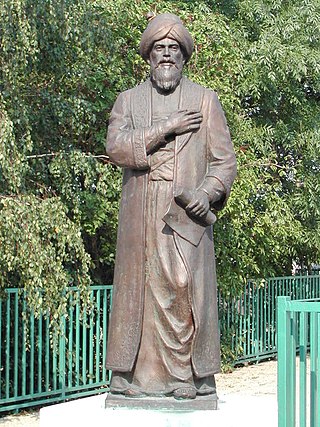Related Research Articles

A wali is most commonly used by Muslims to indicate a saint, otherwise referred to by the more literal "friend of God".

The Encyclopaedia of Islam (EI) is a reference work that focuses on the academic study of Islam. It is published by Brill and provides information on various aspects of Islam and the Islamic world. It is considered to be the standard reference work in the field of Islamic studies. The first edition was published in 1913–1938, the second in 1954–2005, and the third was begun in 2007.

The Eyalet of Kars was an eyalet (province) of the Ottoman Empire. Its reported area in the 19th century was 6,212 square miles (16,090 km2).

Bitlis Vilayet was a first-level administrative division (vilayet) of the Ottoman Empire. Before the Russo-Turkish War (1877–1878) it had been part of the Erzurum Vilayet, it was then made a separate vilayet by the Sublime Porte. It was one of the six Armenian vilayets of the Empire.

The Beylik of Dulkadir was one of the Anatolian beyliks established by the Turkoman clans Bayat, Afshar, and Begdili after the decline of Seljuk Sultanate of Rûm.

Gül Baba, also known as Jafer, was an Ottoman Bektashi dervish poet and companion of Sultan Suleiman the Magnificent who took part in a number of campaigns in Europe from the reign of Mehmed II onwards.

Hakkari, was a historical mountainous region lying to the south of Lake Van, encompassing parts of the modern provinces of Hakkâri, Şırnak, Van in Turkey and Dohuk in Iraq. During the late Ottoman Empire it was a sanjak within the old Vilayet of Van.

Chehriq is a citadel located in north-western Iran in West Azarbaijan Province, Salmas County, near the Turkish border.
The Shekak or Shakkak is a Kurdish tribe present in various regions, mainly in West Azerbaijan province, Iran.

Dervish Ahmed, better known by his pen name Âşıki or his family name Aşıkpaşazade, was an Ottoman historian and a prominent representative of the early Ottoman historiography. He was a descendant of mystic poet dervish Aşık Pasha (1272–1333). He was born in the region of Amasya and studied in various Anatolian towns before going to Hajj and stayed some time in Egypt. He later took part in various Ottoman campaigns, such as the Battle of Kosovo (1448),the Fall of Constantinople and witnessed the circumcision festivities of Mustafa and Bayezid II, the sons of Mehmed the Conqueror. Later in his life he started to write his famous history work Tevārīḫ-i Āl-i ʿOsmān.
Kuyaba was one of the three centers of the Rus or Saqaliba described in a lost book by Abu Zayd al-Balkhi and mentioned in works by some of his followers . The two other centers were Slawiya and Arthaniya.

Abiward or Abi-ward, was an ancient Sassanid city in modern-day Turkmenistan. Archaeological excavations at the ancient city of Abiward have been made in the 20th century about 8 km west of Kaka in an area of 12,000 m2. The central tell is 60 feet high and 700 feet round.

Lütfi Pasha was an Ottoman Albanian statesman, general, and Grand Vizier of the Ottoman Empire under Suleiman the Magnificent from 1539 to 1541. He wrote 21 works mainly on religious topics but also on history, 13 of them written in Arabic and eight in Turkish. Two of his works are the Asafname, a kind of mirror for ministers, and the Tevâriḫ-i Âl-i ‘Os̱mân, dealing with Ottoman history and including his own experiences in the reign of the sultans Bayezid II, Selim I and Suleyman I.

Martijn Theodoor Houtsma, often referred to as M. Th. Houtsma, was a Dutch orientalist and professor at the University of Utrecht. He was a fellow of the Royal Netherlands Academy of Arts and Sciences, and a leading expert on the history of the Seljuks. He remains best known for his work as editor of the first edition (1913–38) of the standard encyclopedic reference work on Islam, the Encyclopaedia of Islam.

The Battle of Niš was fought on 24 September 1689, near the city of Niš in southern Serbia, between the Ottoman Empire and the Holy Roman Empire as part of the Great Turkish War.
Abu-l-Hasan Ali ibn Mohammed al-Tamgruti was a Moroccan author, ambassador, fqih and one of the most important officials of the Saadian court during the reign of Ahmad al-Mansur. He was in charge of the embassy to the Turkish sultan Murad III together with secretary of state Abd al-Aziz al-Fishtali. He is best known because of the rihla of his journey to Istanbul in 1590-91. He was buried in the sanctuary of Qadi Ayyad in Marrakesh.
Enveri was a 15th-century Ottoman Albanian poet and historian. He wrote a famous manuscript on Ottoman history named Dusturname, the Constitutional Book. His work consists of 3730 verses and is based on three parts: the first is a universal Muslim history about the Spread of Islam, the second, which he is famous for, about the Kayi tribe, and the third about the Ottomans. Not much is known about his personal life.

The Sanjak of Siroz or Serres was a second-level Ottoman province encompassing the region around the town of Serres in central Macedonia.
A katib is a writer, scribe, or secretary in the Arabic-speaking world, Persian World, and other Islamic areas as far as the Indian subcontinent. In North Africa, the local pronunciation of the term also causes it to be written ketib. Duties comprised reading and writing correspondence, issue instructions at the command of the person in charge and archiving documentation.
References
- ↑ "mâni (II)", in Modern Turkish Dictionary
- ↑ Volume 5 of E. J. Brill's first encyclopaedia of Islam : 1913 - 1936 / ed. by M. Th. Houtsma, M. Th Houtsma, ISBN 90-04-09796-1, p. 245